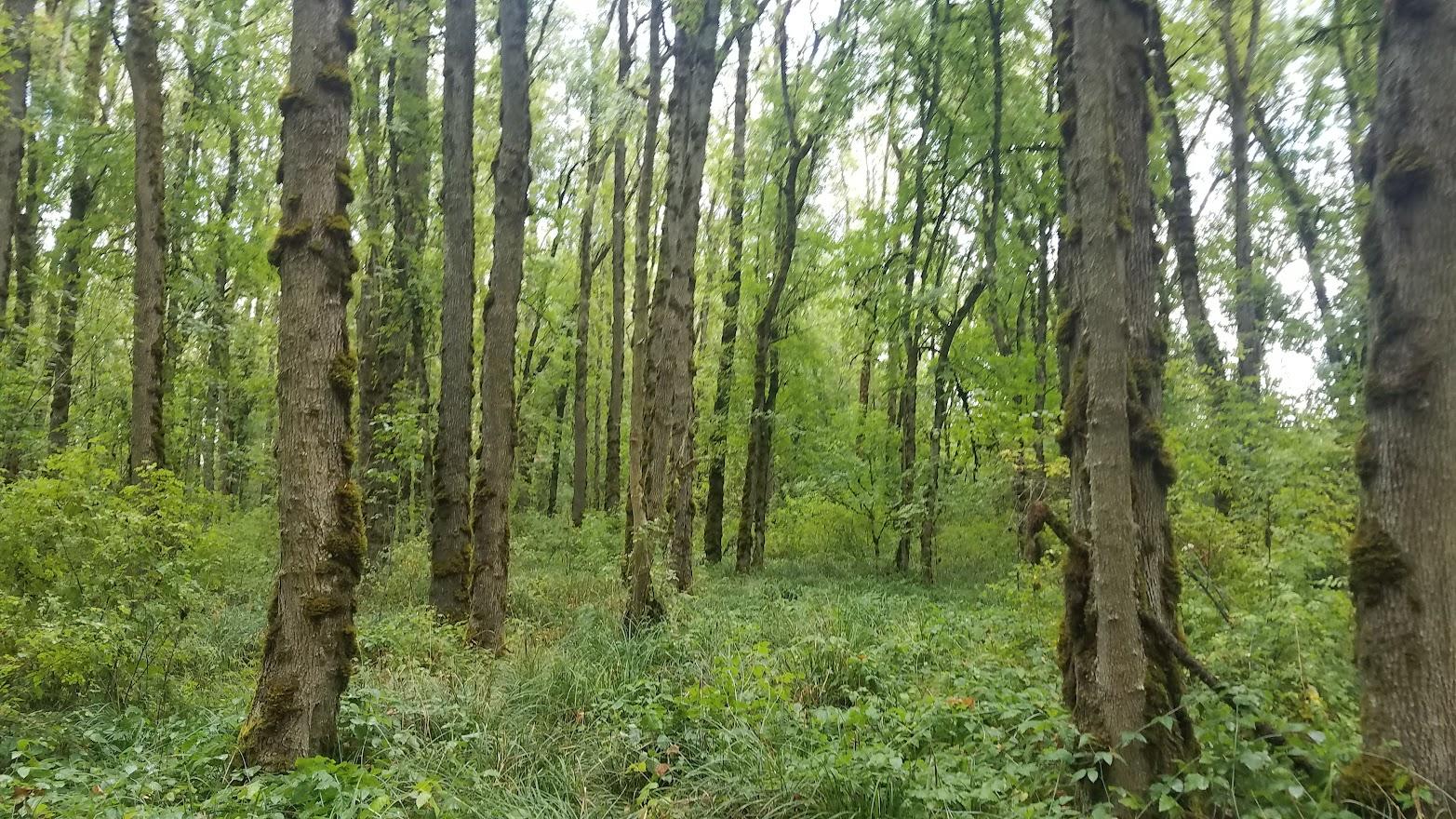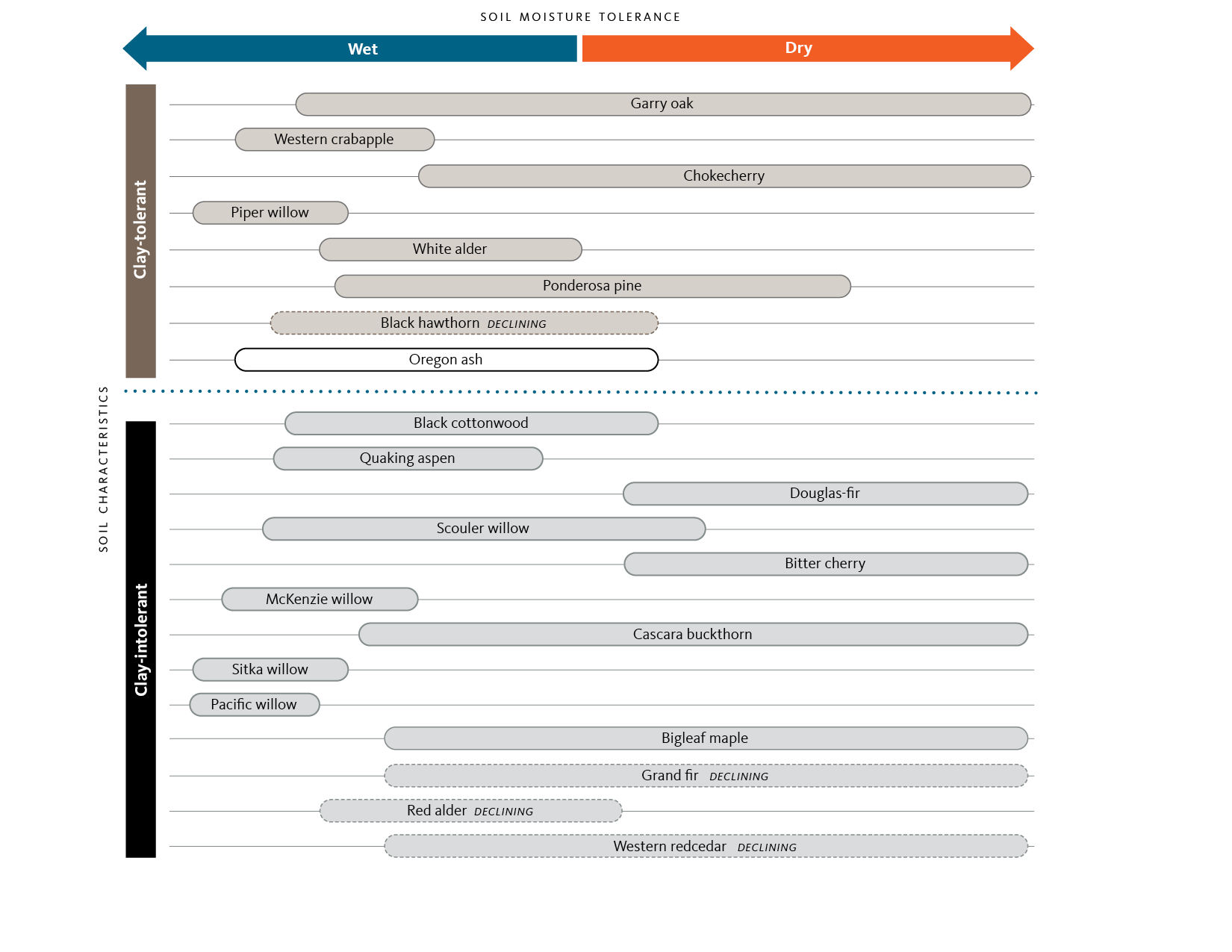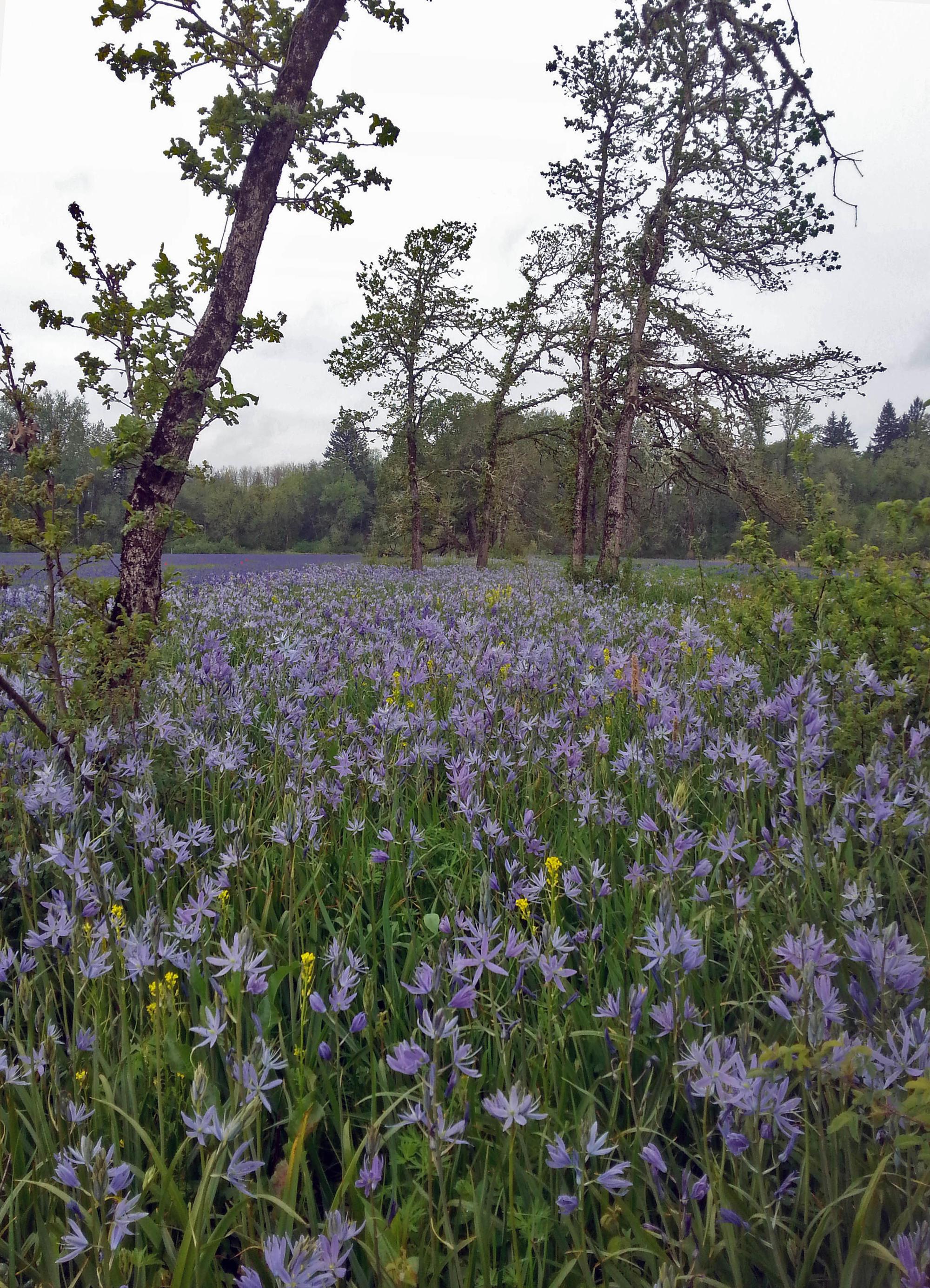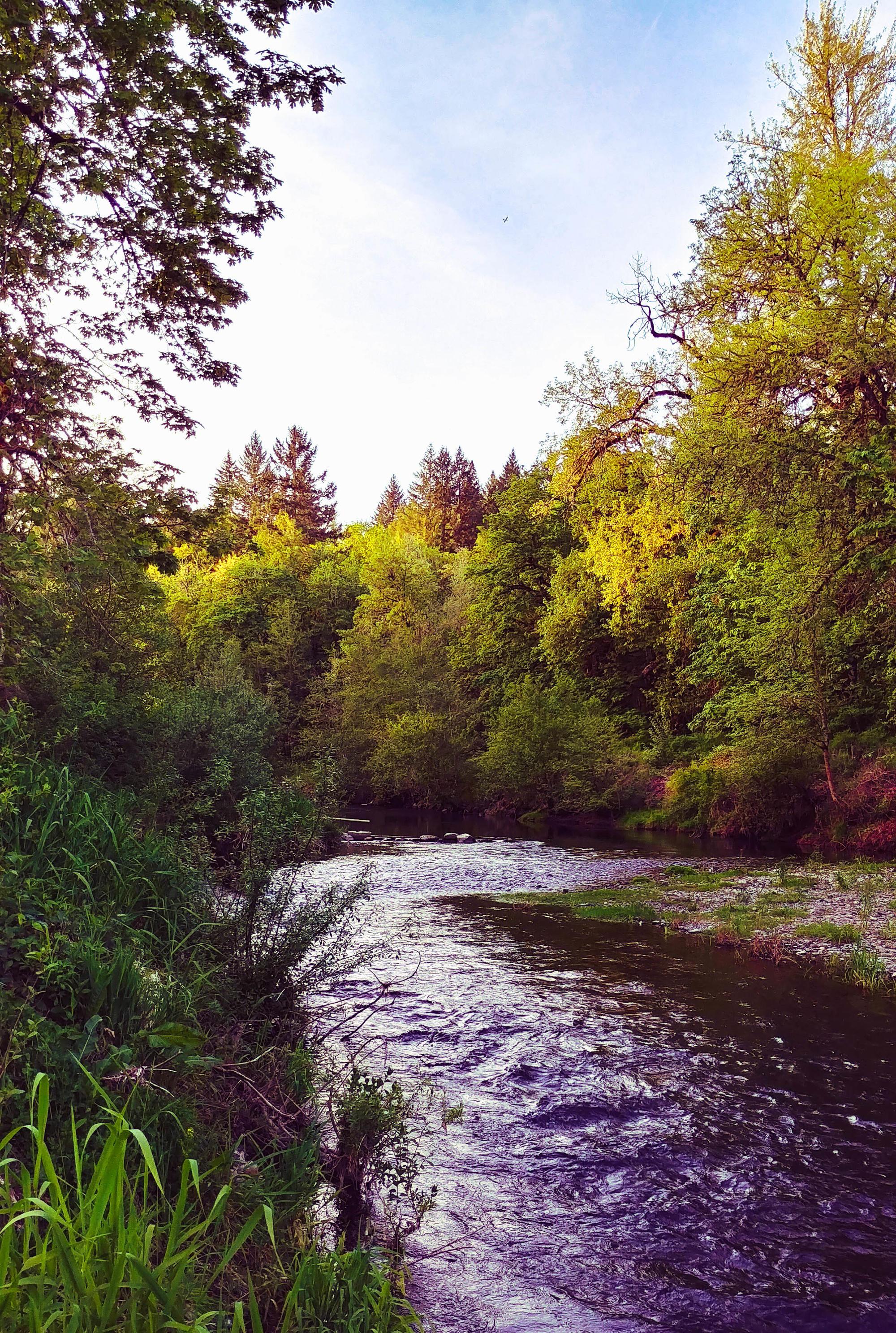Oregon ash occupies a large and varied expanse of habitats in western Oregon. Unfortunately, this ecologically important tree is threatened by the spread of an invasive beetle. The emerald ash borer is expected to cause widespread mortality of Oregon ash. The loss of these trees will leave gaps in mixed stands and large areas of dead trees in pure stands.
This guide will help you choose alternatives to Oregon ash in the variety of habitats it occupies. The information here can also help sustain ash in areas where it might continue to provide essential functions despite the emerald ash borer.
Oregon ash grows in low, wet, clay-based swales and wetlands on broad floodplains, where it often dominates the forest canopy (Figure 1). You will also find ash mixed with other trees along streams and rivers, where soils are often silty, sandy or gravelly, from lower valleys well into the foothills. Other trees associated with ash in these mixed stands include black cottonwood, red alder, grand fir and a variety of other coniferous and hardwood trees (Figure 2).
Figure 3 presents estimates of the environmental tolerances of Oregon ash and other western Oregon wetland and riparian trees. This can help you select replacement species for ash as they are killed by emerald ash borer. The chart incorporates both soil moisture and soil texture (the relative proportions of gravel, sand, silt and clay). These two variables strongly influence what grows where. Soil moisture and texture can vary from site to site, so carefully evaluate your planting location to meet the needs of each species.
Riparian habitats that are frequently flooded in winter but also have well-drained soils host a variety of trees. These differ from wet clays that don’t dry out until June. Both of these habitats, as well as intermediate ones, often support ash.
Well-drained soils
In mixed woodlands along streams and rivers, where soils are generally coarser and better drained, several native species can fill gaps left by dying ash. These include cascara buckthorn, bigleaf maple, red alder, white alder, black cottonwood, certain conifers and a number of willows.
Unfortunately, ongoing studies suggest that at least three of our best riparian tree species — red alder, Western redcedar and grand fir — are experiencing decline, likely due to climate-related stress. Nevertheless, Figure 3 identifies several options to replace ash and help maintain leafy canopies in well-drained soils along streams. In addition to these species, the restoration community is exploring the suitability of riparian species to the south as possible replacements for ash. These include California black oak (Quercus kelloggii) and Oregon myrtlewood (Umbellularia californica) (also called California bay), which are currently native in the Umpqua and Rogue basins. Table 1 lists species to consider replacing ash on well-drained, moist riparian sites.
Table 1. Trees to replace ash in moist riparian systems on well-drained soils, listed in order of soil moisture tolerance, from driest to wettest
- Douglas-fir, Pseudotsuga menziesii
- Bitter cherry, Prunus emarginata
- Bigleaf maple, Acer macrophyllum
- Western redcedar, Thuja plicata
- Grand fir, Abies grandis
- Cascara buckthorn, Rhamnus purshiana
- Scouler willow, Salix scouleriana
- Choke cherry, Prunus virginiana
- California black oak, Quercus kelloggii
- Red alder, Alnus rubra
- Black cottonwood, Populus trichocarpa
- Quaking aspen, Populus tremuloides
- White alder, Alnus rhombifolia
- California bay laurel, Umbellularia californica
- Garry (Oregon white) oak, Quercus garryana
- Black hawthorn, Crataegus gaylussacia
- Piper willow, Salix hookeriana ssp. piperi
- McKenzie willow, Salix prolixa
- Sitka willow, Salix sitchensis
Seasonally and perennially wet clay soils
Some of the most limiting sites for tree diversity in western Oregon are bottomland clays where ash is now frequently dominant. Tight clays that may be wet or even deeply ponded in winter can become droughty by end of August. On these soils, plants have to tolerate both extremes of moisture in sticky, dense clay. While ash is well-adapted to these conditions, sticky, wet clay that becomes droughty in summer is a tough habitat for most trees, including many willows.
The good news is that oak and ponderosa pine can thrive on at least some of these sites. Prior to European settlement, many modern ash stands were savanna-wet prairie complexes occupied by widely scattered oak and sometimes pine. Ash has invaded these former savanna-wet prairie complexes as a result of the loss of frequent fire. Generally, if you see a stand of ash on heavy clay on a valley floor, you are likely to find occasional oaks mixed in as well, at least on the drier fringes. Sometimes, these oaks are legacy trees older than the invading ash.
On seasonally wet clay sites, consider converting dying ash stands to oak savanna-wet prairie. Savannas are open grasslands with widely scattered trees. Garry oak is the premier savanna tree species in western Oregon and supports a broad diversity of wildlife species. In all, savanna-wet prairie complexes (Figure 4) are among the richest systems we have in terms of plant species diversity, wildlife habitat and pollinators. Even where no oaks are currently present, planting Garry oak may help restore long-term, high-value hardwood canopy in drier portions of these systems. Herbaceous plants such as camas and checkermallow are also important elements in these systems. Many of these herbaceous species are now rare, and some may even benefit from the loss of ash canopy.
On the wettest clay sites, tree choices are limited. In heavy soil that remains saturated through early summer or later, woody plant options include just a few shrubs (spirea, swamp rose, dogwood) and small trees (Western crab apple). Herbaceous species such as sedges, rushes, and wetland grasses and wildflowers may also be good options for native cover and diversity on some wet ash sites.
Table 2 provides tree species to consider for valley-floor clay sites.
Table 2. Trees to replace ash in moist to wet silty clay and clay soils on valley floors, listed by soil moisture tolerance, from driest to wettest
- Chokecherry, Prunus virginiana
- White alder, Alnus rhombifolia
- Ponderosa pine, Pinus ponderosa
- Garry (Oregon white) oak, Quercus garryana
- Black hawthorn, Crataegus gaylussacia
- Western crabapple, Malus fusca
- Piper willow, Salix hookeriana ssp. piperi
Ash and beaver
Beaver are a keystone species. They build dams and cut woody vegetation, profoundly influencing and supporting healthy streams and wetlands. In turn, wetlands and streams support numerous species of wildlife and fish such as salmon. Beaver feed on ash and build dams with it. To fulfill this function, ash need only achieve sapling size (1 to 2 inches in basal diameter). It may be desirable to continue planting and maintaining ash along streams and wetlands where beaver provide this valuable service.






